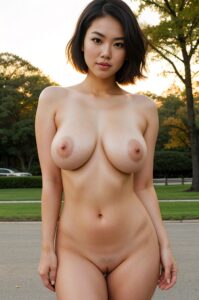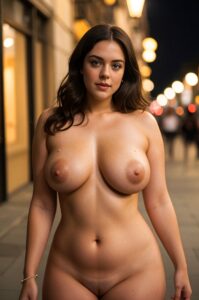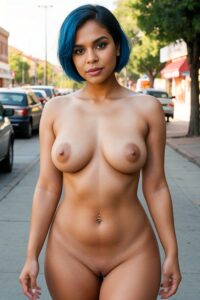
-
Article title
Introduction:
The portrayal of big boobs in the media has had a significant impact on pop culture and society. Throughout history, the media has often emphasized and exaggerated the importance of larger breast sizes, perpetuating certain beauty standards and influencing societal perceptions of femininity. This influence can be seen in various forms of media, including advertisements, movies, television shows, and music videos. The impact of this representation has both positive and negative implications, shaping societal attitudes towards body image, self-esteem, and gender roles. Understanding the influence of big boobs in the media is crucial for analyzing the broader implications it has on pop culture and society as a whole.
The Representation of Big Boobs in Advertising: A Critical Analysis
Big Boobs in the Media: The Impact on Pop Culture and Society
The Representation of Big Boobs in Advertising: A Critical Analysis
Hey there, lovely readers! Today, we’re diving into a topic that has been a hot button issue for quite some time – the representation of big boobs in advertising. It’s no secret that the media plays a significant role in shaping our perceptions of beauty and body image. And when it comes to breasts, the portrayal can be both fascinating and problematic.
Let’s start by acknowledging that breasts come in all shapes and sizes, and there is no one-size-fits-all definition of beauty. However, the media often perpetuates a narrow and unrealistic standard of what is considered attractive. This is particularly evident in the way big boobs are portrayed in advertising.
When we turn on the TV or flip through a magazine, it’s hard to miss the abundance of busty models and actresses. They are often depicted as objects of desire, with their ample cleavage front and center. This constant bombardment of images can create a distorted perception of what is normal or desirable, leading many women to feel inadequate or insecure about their own bodies.
Moreover, the representation of big boobs in advertising tends to focus solely on their sexual appeal. They are often used as a tool to sell products, with advertisers capitalizing on the idea that sex sells. This reduction of women to mere sexual objects not only perpetuates harmful stereotypes but also undermines their intelligence, talents, and achievements.
It’s important to recognize that this narrow representation of big boobs in advertising is not only damaging to women but also to men. By perpetuating the idea that big boobs are the epitome of beauty, men may feel pressured to conform to societal expectations and seek out partners solely based on physical appearance. This can lead to shallow relationships and a lack of appreciation for the many other qualities that make a person truly attractive.
But it’s not all doom and gloom! There is a growing movement within the advertising industry to challenge these narrow beauty standards and promote diversity and inclusivity. Brands are starting to feature models with a range of body types, including those with big boobs, in their campaigns. This shift is not only empowering for women but also sends a powerful message that beauty comes in all shapes and sizes.
As consumers, we also have a role to play in shaping the media landscape. By supporting brands that embrace diversity and inclusivity, we can send a clear message that we value representation and reject harmful stereotypes. Additionally, we can engage in conversations about body positivity and challenge the unrealistic beauty standards perpetuated by the media.
In conclusion, the representation of big boobs in advertising has a significant impact on pop culture and society. It perpetuates narrow beauty standards, objectifies women, and undermines the value of other qualities. However, there is hope for change as the industry slowly embraces diversity and inclusivity. By supporting brands that promote body positivity and engaging in conversations about beauty standards, we can contribute to a more inclusive and empowering media landscape. Remember, beauty is not defined by the size of your boobs, but by the confidence and love you have for yourself.
Big Boobs in Film and Television: Shaping Beauty Standards
Big Boobs in the Media: The Impact on Pop Culture and Society
When it comes to beauty standards, the media has always played a significant role in shaping our perceptions. One aspect that has been particularly influential is the portrayal of big boobs in film and television. From iconic characters to glamorous celebrities, the media has often celebrated and emphasized this physical attribute. However, the impact of this representation goes beyond mere entertainment, as it has profound effects on society and the way we perceive ourselves.
In the world of film and television, big boobs have often been associated with beauty and desirability. From Marilyn Monroe’s iconic curves to Pamela Anderson’s voluptuousness in “Baywatch,” these characters have become symbols of femininity and sex appeal. The media has perpetuated the idea that having big boobs is a prerequisite for being attractive, leading many women to feel inadequate if they don’t fit into this narrow definition of beauty.
This emphasis on big boobs in the media has also contributed to the objectification of women. In many films and TV shows, female characters with big boobs are often portrayed as mere eye candy, existing solely for the pleasure of the male gaze. This objectification not only reduces women to their physical appearance but also reinforces harmful gender stereotypes. It sends a message that a woman’s worth is determined by her physical attributes rather than her intelligence, talents, or personality.
Moreover, the media’s obsession with big boobs has had a significant impact on body image issues. Many women feel pressured to conform to these unrealistic beauty standards, leading to body dissatisfaction and low self-esteem. The constant bombardment of images featuring women with big boobs can create an unattainable ideal that leaves many feeling inadequate and insecure about their own bodies. This can have serious consequences for mental health, as individuals strive to achieve an impossible standard of beauty.
It is important to recognize that the media’s portrayal of big boobs is not reflective of the diversity of real women’s bodies. The emphasis on this one physical attribute perpetuates a narrow and unrealistic beauty standard, excluding those who do not naturally possess big boobs. This lack of representation can make individuals who don’t fit into this mold feel marginalized and invisible, further perpetuating feelings of body shame and inadequacy.
However, it is not all doom and gloom. In recent years, there has been a growing movement towards body positivity and inclusivity in the media. More and more, we are seeing diverse body types being celebrated and represented on screen. This shift is crucial in challenging the narrow beauty standards that have been perpetuated for so long. By showcasing a range of body types, including those without big boobs, the media can help promote a more inclusive and realistic representation of beauty.
In conclusion, the portrayal of big boobs in film and television has had a significant impact on pop culture and society. It has shaped beauty standards, perpetuated objectification, and contributed to body image issues. However, there is hope for change as the media becomes more inclusive and diverse in its representation of beauty. It is essential for us as consumers to be critical of the media we consume and demand more realistic and inclusive portrayals of women’s bodies. Only then can we begin to challenge the harmful impact of big boobs in the media and create a more accepting and inclusive society.
The Influence of Big Boobs on Fashion Trends and Body Image
Hey there, lovely readers! Today, we’re diving into a topic that has been a hot button issue for quite some time: big boobs in the media and their impact on pop culture and society. In this section, we’ll be exploring the influence of big boobs on fashion trends and body image. So, grab a cup of tea and let’s get started!
It’s no secret that the media plays a significant role in shaping our perception of beauty and what is considered attractive. For years, big boobs have been glorified and portrayed as the epitome of femininity. From movies to magazines, it seems like everywhere we turn, we’re bombarded with images of women with ample bosoms.
This obsession with big boobs has undoubtedly influenced fashion trends. Just take a stroll down any high street, and you’ll see countless stores selling push-up bras, padded tops, and plunging necklines. The fashion industry has capitalized on the idea that bigger is better, perpetuating the notion that women with smaller chests are somehow less desirable.
But what does this mean for body image? Well, it’s no secret that the media’s portrayal of big boobs has had a profound impact on how women perceive their own bodies. Many women feel pressured to conform to this idealized image of beauty, leading to feelings of inadequacy and low self-esteem.
The constant bombardment of images featuring women with big boobs can make those who don’t fit into this mold feel like they don’t measure up. This can lead to body dysmorphia and a never-ending quest for the perfect body. It’s important to remember that beauty comes in all shapes and sizes, and no one should feel pressured to change their appearance to fit societal standards.
Fortunately, there has been a shift in recent years towards body positivity and inclusivity. Many brands are now embracing diversity and featuring models with a range of body types, including those with smaller chests. This is a step in the right direction, as it helps to challenge the narrow definition of beauty that has been perpetuated for far too long.
It’s also worth noting that big boobs aren’t all they’re cracked up to be. While they may be seen as desirable by some, they can also come with their fair share of challenges. Back pain, difficulty finding clothes that fit properly, and unwanted attention are just a few of the issues that women with big boobs may face on a daily basis.
So, what can we do to combat the negative impact of big boobs in the media? First and foremost, we need to continue promoting body positivity and embracing all body types. It’s essential to celebrate diversity and challenge the unrealistic beauty standards that have been ingrained in our society.
Additionally, we can support brands that are inclusive and feature a range of body types in their advertising campaigns. By voting with our wallets, we can send a message to the fashion industry that we want to see more diversity and representation.
In conclusion, the influence of big boobs on fashion trends and body image is undeniable. However, it’s crucial to remember that beauty comes in all shapes and sizes. By promoting body positivity and embracing diversity, we can help create a more inclusive society where everyone feels comfortable and confident in their own skin. So, let’s celebrate our bodies, no matter their size, and remember that we are all beautiful in our own unique way.
Big Boobs in Music Videos: Objectification or Empowerment?
Hey there, fellow readers! Today, we’re diving into a topic that has been a hot button issue in recent years: big boobs in the media. Specifically, we’ll be exploring their impact on pop culture and society. In this section, we’ll be focusing on big boobs in music videos and whether they are seen as objectification or empowerment. So, let’s get started!
Music videos have long been a platform for artists to express themselves creatively and visually. However, they have also been criticized for perpetuating harmful stereotypes and objectifying women. When it comes to big boobs in music videos, opinions are divided.
On one hand, some argue that featuring big boobs in music videos is a form of objectification. They argue that these videos often focus solely on the physical attributes of women, reducing them to mere objects of desire. Critics claim that this perpetuates unrealistic beauty standards and reinforces the idea that a woman’s worth is solely based on her appearance.
However, there are others who argue that big boobs in music videos can be a form of empowerment. They believe that artists should have the freedom to express themselves in any way they choose, including showcasing their physical attributes. These supporters argue that it is a celebration of body positivity and self-confidence, allowing women to embrace and flaunt their natural assets without shame.
It’s important to note that the impact of big boobs in music videos goes beyond just the visuals. The lyrics and overall message of the song also play a significant role in shaping the perception of these videos. If the lyrics objectify women or promote harmful stereotypes, then the inclusion of big boobs in the video can further reinforce these negative ideas. However, if the lyrics and message are empowering and promote self-love, then the inclusion of big boobs can be seen as a reflection of that message.
Transitional phrase: Now, let’s take a look at some examples of music videos that have sparked conversations around big boobs.
One such example is the iconic music video for “WAP” by Cardi B and Megan Thee Stallion. This video features women of all shapes and sizes, including those with big boobs, confidently embracing their sexuality. The lyrics of the song are unapologetically explicit, but they also emphasize female empowerment and sexual agency. Many argue that this video is a prime example of big boobs being portrayed in a way that is empowering rather than objectifying.
On the other hand, there are music videos that have faced backlash for their portrayal of big boobs. For instance, Robin Thicke’s “Blurred Lines” received criticism for its objectification of women, including those with big boobs. Critics argued that the video reduced women to mere props for male pleasure, reinforcing harmful gender dynamics.
Transitional phrase: So, what does all of this mean for pop culture and society?
The inclusion of big boobs in music videos reflects the broader societal attitudes towards women’s bodies. It highlights the ongoing struggle between objectification and empowerment. While some argue that these videos perpetuate harmful stereotypes and unrealistic beauty standards, others see them as a celebration of body positivity and self-confidence.
Ultimately, the impact of big boobs in music videos depends on the context in which they are presented. When used to objectify and demean women, they contribute to a culture that devalues women based on their physical appearance. However, when used to empower and celebrate women, they can challenge societal norms and promote self-acceptance.
In conclusion, the portrayal of big boobs in music videos is a complex issue that sparks debates about objectification and empowerment. It is crucial to critically analyze these videos and consider the overall message they convey. By doing so, we can contribute to a more inclusive and respectful pop culture that celebrates diversity and promotes positive body image.
Q&A
1. How does the portrayal of big boobs in the media impact pop culture and society?
The portrayal of big boobs in the media can perpetuate unrealistic beauty standards, objectify women, and contribute to body image issues.
2. What are some potential negative effects of the media’s focus on big boobs?
Some potential negative effects include increased pressure on women to conform to a specific body type, decreased self-esteem among those who do not fit the ideal, and the reinforcement of harmful stereotypes.
3. Are there any positive aspects to the media’s portrayal of big boobs?
While some argue that the media’s portrayal of big boobs can empower women who naturally possess them, it is important to consider the overall impact on body image and the potential harm caused by unrealistic beauty standards.
4. How can society address the impact of big boobs in the media?
Society can address the impact by promoting diverse body representation, challenging beauty standards, and encouraging media literacy to help individuals critically analyze and question the messages they receive from the media.In conclusion, the portrayal of big boobs in the media has had a significant impact on pop culture and society. It has perpetuated unrealistic beauty standards, objectification of women, and reinforced gender stereotypes. This representation has influenced societal perceptions of attractiveness, body image issues, and self-esteem. It is important to critically analyze and challenge these media narratives to promote inclusivity, body positivity, and respect for diverse body types.






















